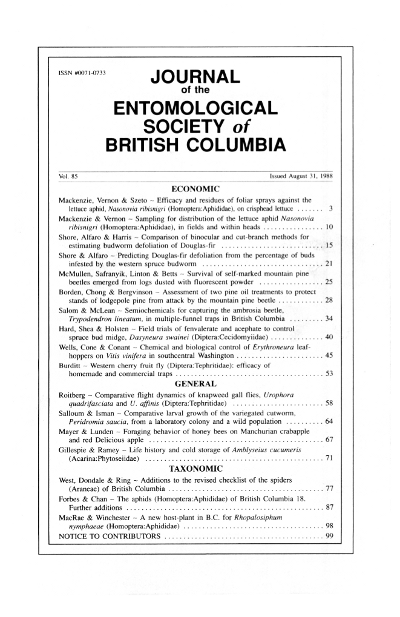Assessment of two Pine Oil Treatments to Protect Stands of Lodgepole Pine from Attack by the Mountain Pine Beetle
Abstract
Pine oil (Norpine-65) was evaluated as an infestation deterrent for the mountain pine beetle, Dendroctonus ponderosae Hopkins, in a high hazard forest of lodgepole pine, Pinus contorta var. latifolia Engelmann. Two experimental treatments were tested, each in four, 9 ha, square blocks (replicates): 1) spraying trees in a grid at 50m centres with 1.8 L of pine oil/tree, and 2) creating a " barrier" consisting of a double line of pine oil sprayed trees, 25 m apart, 25 m with in the block boundary. There were significantly reduced ratios of newly-infested (green) trees to the previous year's infested (red) trees in both treatments compared to control blocks. However. neither treatment prevented beetles from attacking semiochemical-baited trees 75 m in side the block boundaries, and neither treatment is recommended for operational use. At maximum costs/ha of $22.04 and $43.39 (Can.) for grid and barrier treatments. respectively, the operational use of a repellent. or an insecticide would approach cost effectiveness if it reduced new infestations of D. ponderosae by 1 or 2 trees/ha. respectively.Downloads
Issue
Section
License
Authors who publish with the Journal of the Entomological Society of British Columbia agree to the following terms:
-Authors retain copyright and grant the journal right of first publication with the work simultaneously licensed under a Creative Commons Attribution License that allows others to share the work with an acknowledgement of the work's authorship and initial publication in this journal.
-Authors are able to enter into separate, additional contractual arrangements for the non-exclusive distribution of the journal's published version of the work (e.g., post it to an institutional repository or publish it in a book), with an acknowledgement of its initial publication in this journal.
-Authors are permitted and encouraged to post their work online (e.g., in institutional repositories or on their website) prior to and during the submission process, as it can lead to productive exchanges, as well as earlier and greater citation of published work (See The Effect of Open Access).


